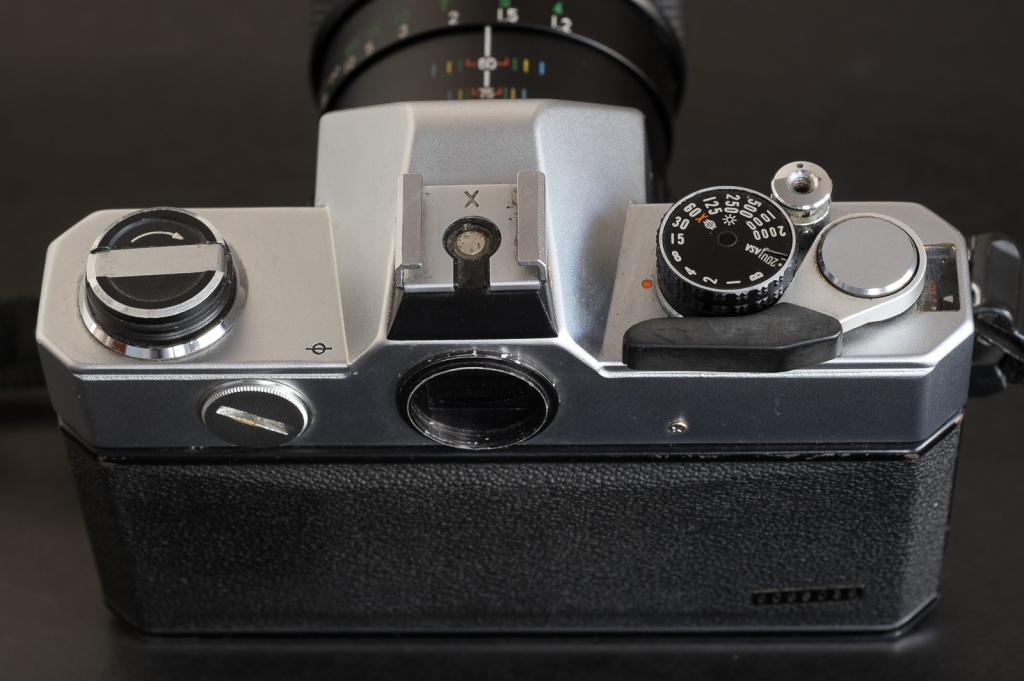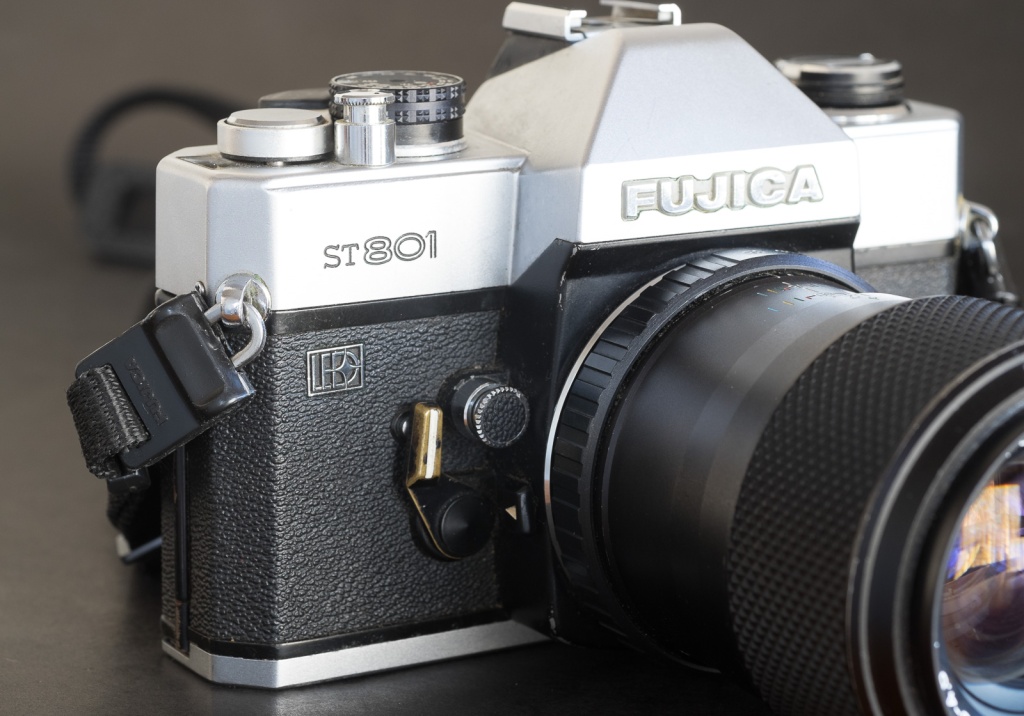Fuji Photo Film has been in the photo business since 1934, but only entered the single lens reflex camera (SLR) market at the beginning of the 70s. At that time, Pentax, Minolta, Nikon and Canon had been selling SLRs for more than 10 years.
Fuji introduced important innovations – the Fujica ST701 was the first SLR using a silicon photo-diode for exposure metering, and in 1974, the ST901 was the first camera to use numerical LEDs to show the selected shutter speed in the viewfinder.
But Fuji bet on the wrong lens mount – their first SLR had a “universal” m42 screw mount that only supported stop down metering at a time when the market was already demanding full aperture metering. They rapidly had to create a proprietary derivative of the “universal” mount to support it. Their implementation (a protruding tab on the outside of the aperture ring to transmit aperture information to the camera) was clever and maintained the inter-compatibility of the lenses with the cameras of other vendors (I tested Fujinon lenses on Pentax and Yashica cameras – and there was no problem).
In 1979, Fuji was the last major vendor to abandon the screw mount, and finally launched a brand new proprietary bayonet, the “X” mount, supporting all types of auto-exposure modes.

Switching to a new lens mount is always a difficult exercise for a camera manufacturer, as it’s a powerful signal sent to its installed base that the investment they’ve made in the lenses of the brand is going to be worthless; at some point, the photographer will need a new camera to replace the existing one, and that day, he/she will also have to buy a whole new set of lenses. But if you have to buy everything anew, why stay with the brand that “betrayed” you?
The m42 bodies (Fujica ST 701, 705, 801, 901) were technically innovative and were praised by the press, but the bayonet mount cameras (Fujica STX, AX-1, AX-3, AX-5) were nice but unremarkable me-too products that never found much traction on a market place dominated by Canon and Minolta. When Minolta launched the first modern autofocus SLR, the Maxxum 7000, in 1985, Fuji was already folding down its SLR business, and did not even try to launch its own line of autofocus SLRs. They left the market for good in 1987.
Today, some of the Fujica screw mount cameras are highly regarded by the supporters of the m42 Universal mount. They were very modern when they were launched, and are far more pleasant to use than cameras of the same generation such as the Pentax Spotmatic.
- I would avoid all cameras requiring Mercury batteries (ST 701, ST601) as they are not compatible with the silver oxide batteries that most other cameras of the same vintage accept (as does the Pentax Spotmatic, for instance).
- The ST901 is an interesting curiosity (the first camera with a numeric LED display in the viewfinder), but it’s 1.0 implementation of the feature and the camera only has an aperture priority auto exposure mode (no semi-auto exposure control).
- The AZ-1 is a derivative of the ST901, without the numeric display in the viewfinder, and was the first SLR from a major vendor to be equipped with a zoom as its standard lens. But it does not constitute a reason to buy an AZ-1 now, as it offers very little control of the exposure parameters to the photographer (the exposure metering only works in the automatic exposure mode – there is no semi-automatic mode, it’s automatic or fully manual).
 Fujica AZ-1 and Fujinon-X f/3.5-4.5 43mm-75mm zoom – the AZ-1 was the first mass market SLR bundled with a zoom instead of the standard 50mm lens.
Fujica AZ-1 and Fujinon-X f/3.5-4.5 43mm-75mm zoom – the AZ-1 was the first mass market SLR bundled with a zoom instead of the standard 50mm lens.
It leaves us with the ST801 and ST705 (both semi-auto cameras with full aperture metering), and the ST605 (an entry level semi-auto camera with stopped down metering and a slower shutter).
- the ST 801 boasts a silicon diode cell for metering, LEDs in the viewfinder, silver oxide batteries, 1/2000 shutter, and a very bright viewfinder. It was produced from 1972 to 1978. It’s still perfectly usable today and can be found at reasonable prices (less than $50.00) if you are patient and wait for a good opportunity.
- The ST605 is really abundant and cheap ($10 to $30), but is very limited (slow shutter and stopped down metering). The ST705, which looks like a good compromise on paper, was only produced for two years, just before the launch of the Fujica X mount cameras. As a result, it’s much more difficult to find.
Fujinon lenses have an excellent reputation in the world of m42 lenses and apart from the 50 or 55mm lenses which are abundant, they are pretty rare. As the result, they’re probably the most expensive m42 screw mount lenses you can find on eBay. In particular, they are significantly more expensive than equivalent (and similarly highly rated) Pentax screw mount lenses.
Tamron used to sell an Adaptall 2 ring specifically designed for Fujica’s full aperture metering system. Tamron Adaptall lenses are more abundant than Fujica’s, and are an interesting option if you don’t want to spend $500.00 on a Fujica EBC Wide Angle lens (for instance).
ST 801
The ST801 was the top of the line of Fujica in the seventies – it was significantly more expensive (maybe 25% more) than the Pentax Spotmatic F – which would have been its closest competitor in the word of screw mount cameras, and was probably in the same price bracket as Nikon’s Nikkormat.


- The ST801 had a long career (1972-1978) and no real successor in the Fujica line up. The Fujica AX cameras that followed benefited from multiple automatic exposure modes and could be fitted with a winder, but their shutters and viewfinders were not as good as the ST801’s.
- Its modern metering system was distinguishing the ST801 from its competitors (silicon metering cell, LEDs in the viewfinder – no fragile galvanometer- , Silver Oxide batteries). The ST801 aged well in that regard.
- It’s a very pleasant camera to use – the viewfinder is very bright and clear, the eye relief is OK for a camera launched in 1972. It’s easy to compose and focus, the commands are few and logical, and the camera is relatively small and light.
- It works at full aperture with Fujinon lenses. Full aperture metering really makes a difference in ease of use. If possible, buy Fujinon lenses, or if you can’t find them, Tamron Adaptall lenses with the specific Fujica mount.
- It meters stopped down with non-Fuji 42mm screw mount lenses. It’s a bit acrobatics as usual – press simultaneously Depth of Field lever to stop down the lens and the shutter release half way for metering – it works but there is an issue: when the DOF lever is pressed, the shutter release becomes over-sensitive and it’s very easy to take a picture inadvertently while trying to do a metering.
- No motor drive – not an issue today but could have been in the mid seventies.
- It has a reputation for being a “delicate” camera – I don’t know if it’s justified – Olympus OM-1 cameras were also shunned by press photographers because they were “fragile”. It could have been a reaction from people used to the large and heavy Nikon cameras of that time – so solid that you could (supposedly) use them to drive nails in a wall.

Conclusion – for a camera of the early 70’s, the Fujica ST801 is much more usable than equivalent models from Nikon or Canon. The viewfinder is brighter, the metering system is modern and reactive, and the body is comparatively smaller and lighter. The contrast with the Pentax models of the same era (Spotmatic) is also striking. Maybe it’s because of the sorry state of most of the copies of the Spotmatic you can find today, but a Pentax feels really clunky compared to the ST801. The Fujica is much more satisfying to use.
In my opinion, the ST801 is the best screw mount Fujica camera, and arguably the best 42mm screw mount semi-automatic camera to reach the mass market. Ever.
